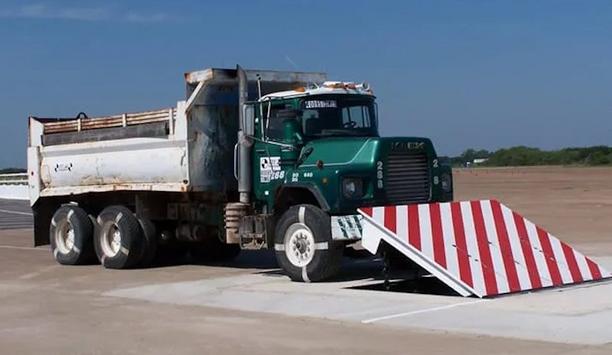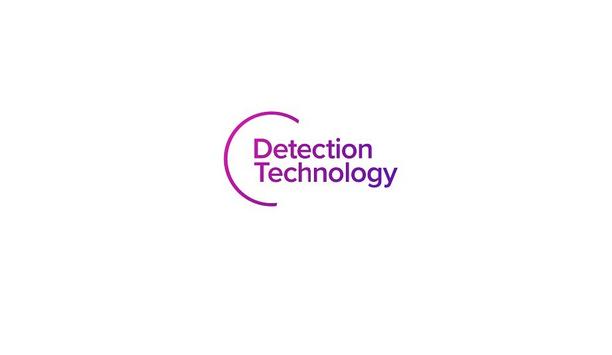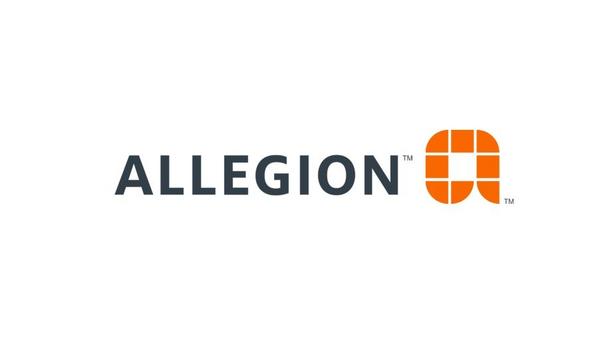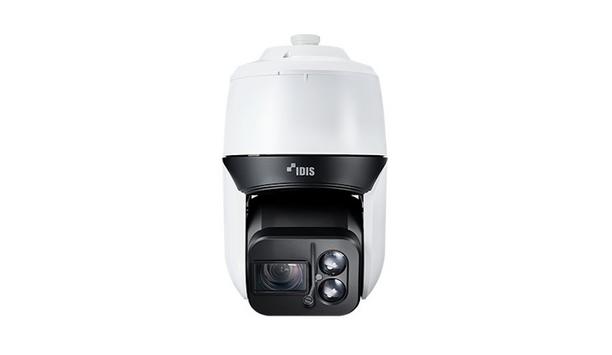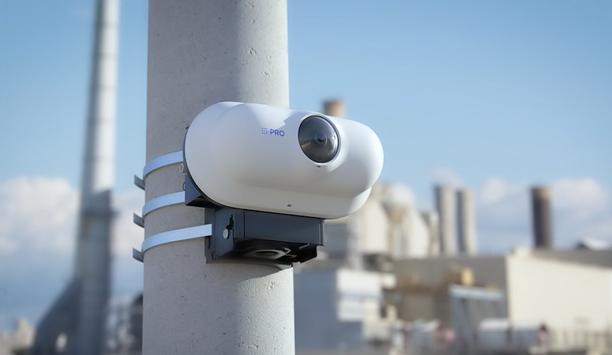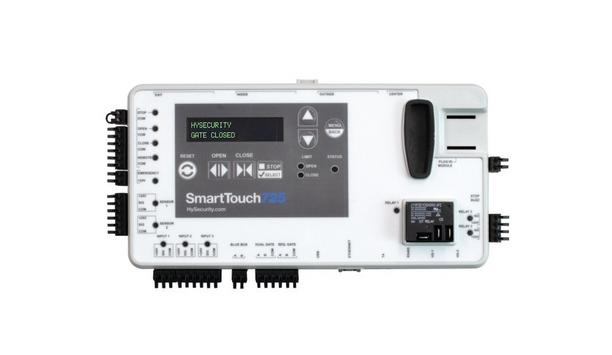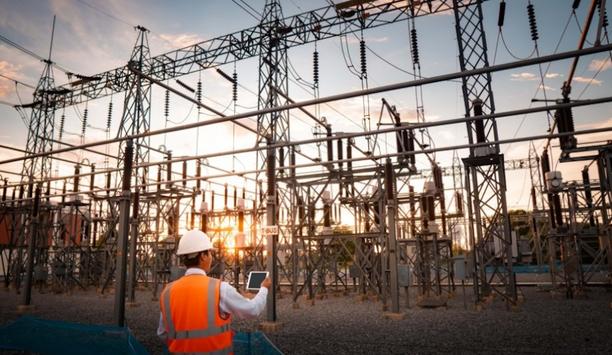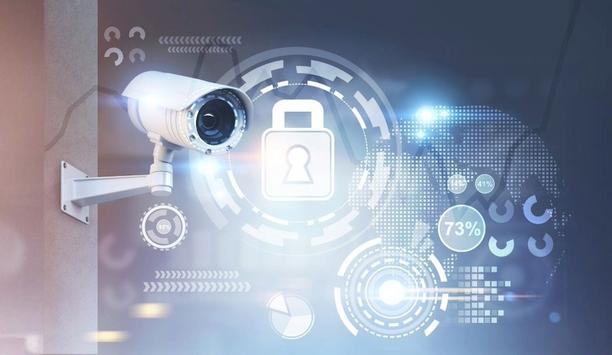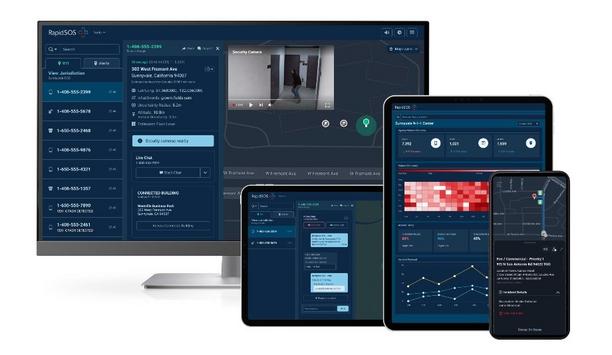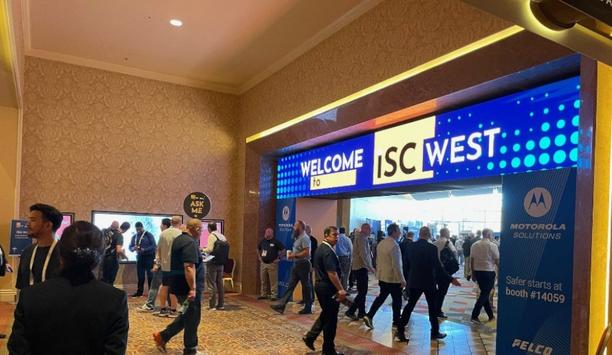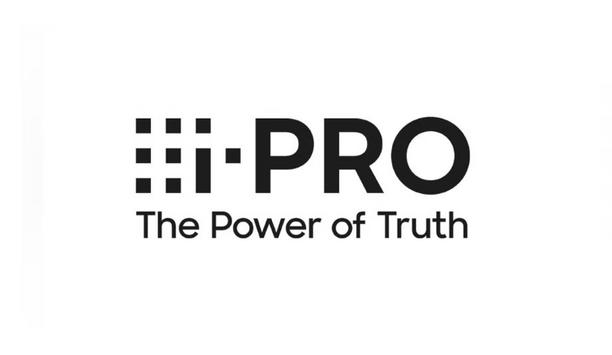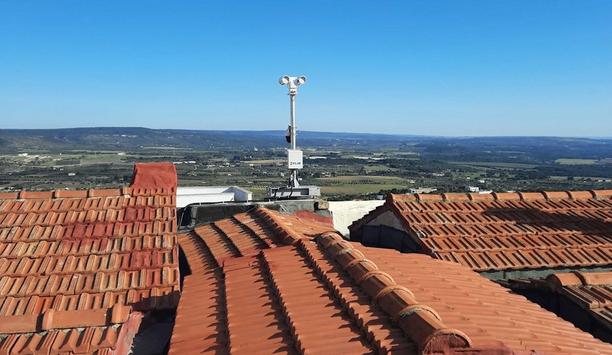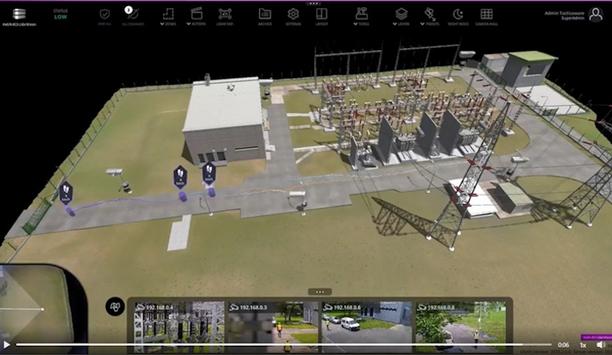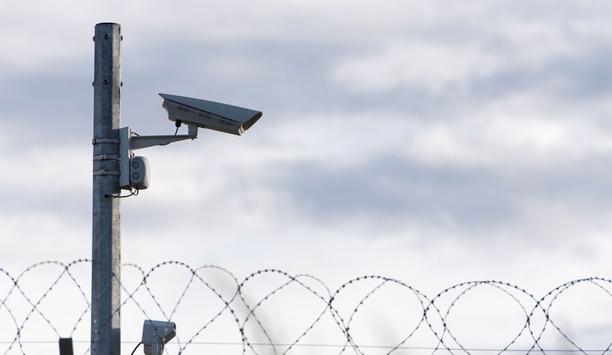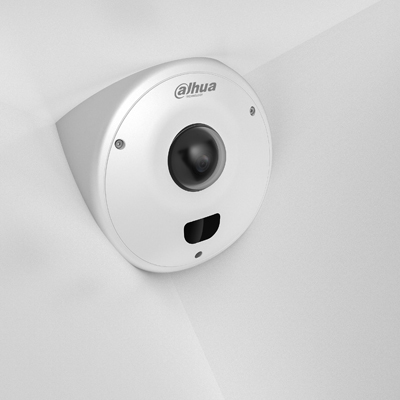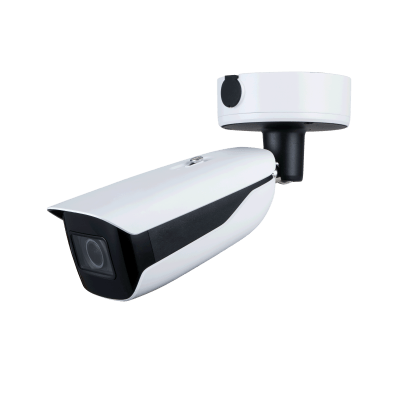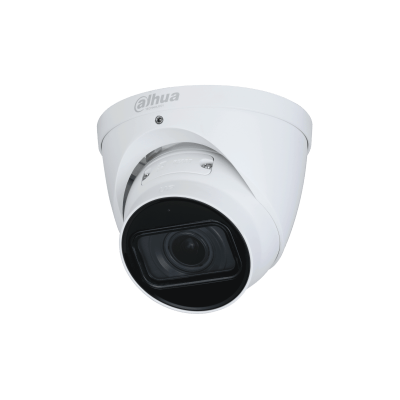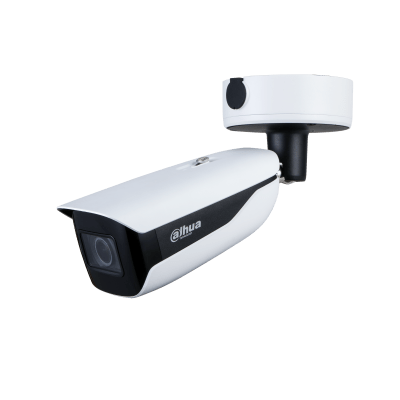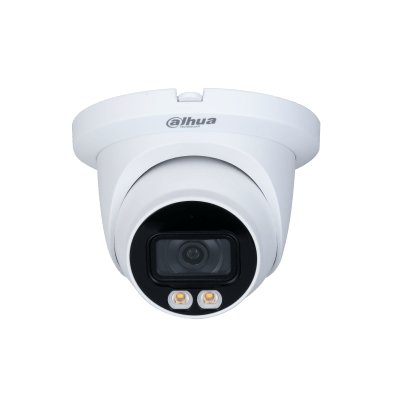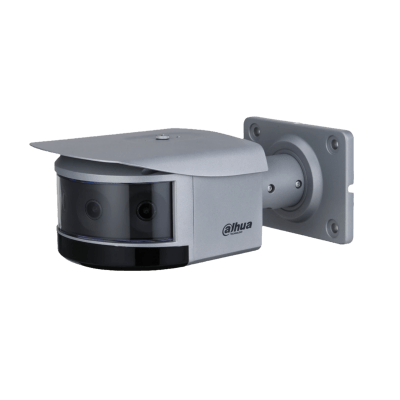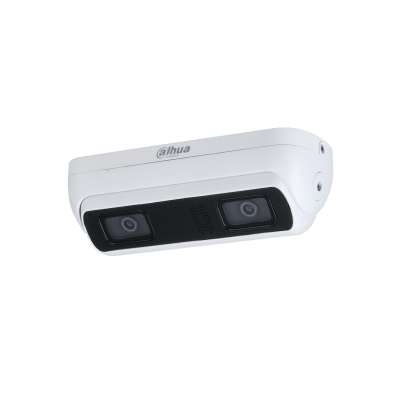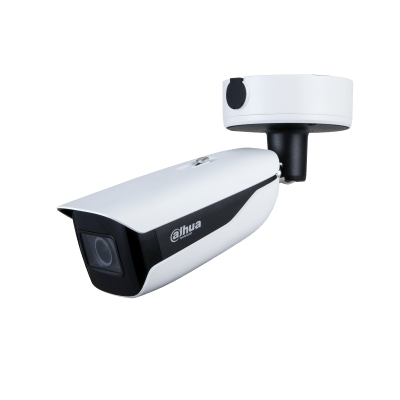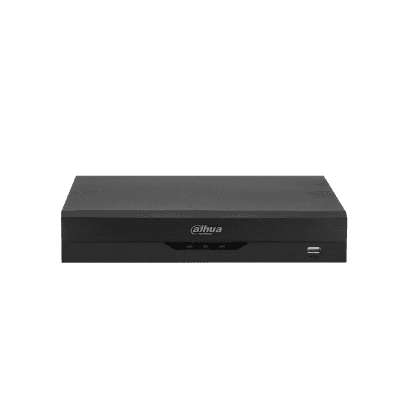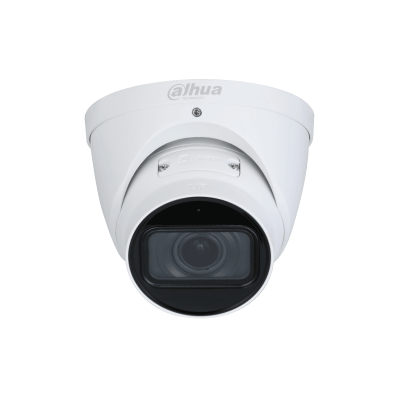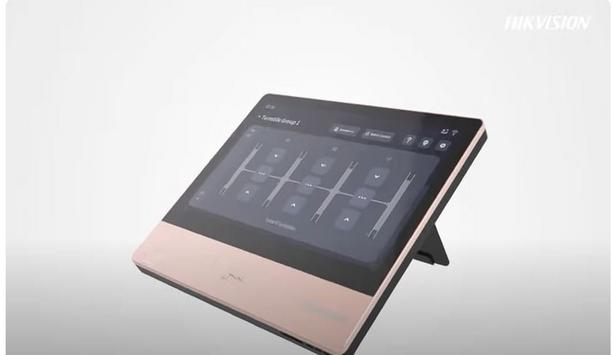Perimeter security
A wedge barrier system is one of the most effective physical security measures for stopping unauthorized vehicles from accessing a restricted area. Designed for high-threat environments, these barriers prevent breaches that could cause significant harm to people, property, or critical infrastructure. Understanding what a wedge barrier is will help they determine if it’s the right solution for the security plan. What does a wedge barrier system do? A wedge barrier is a heavy-du...
Integrated access control and security manufacturer TDSi now announces that from 1st January 2026, it will operate under the new name: TDSi by Hirsch. The change follows the global transformation of its parent company, Vitaprotech, into the Hirsch Group, unifying its security brands worldwide under one trusted name. TDSi’s integrated access control For more than 40 years, TDSi’s integrated access control solutions have been at the heart of thousands of installations&nbs...
Global security manufacturer Gallagher Security is proud to announce a strategic partnership with Fortified Security, a pioneering perimeter systems integrator with over 30 years of specialized experience. This collaboration enables Gallagher’s Channel Partners across the Americas to offer enhanced perimeter security solutions to their customers, supported by Fortified’s expert design and installation services. Long-term client relationships This partnership empowers Gallagh...
Detection Technology Plc has updated its strategy for 2026-2030. In line with the DT2030 strategy, the company aims to outgrow the global X-ray detector market by increasing added-value and focusing on the fastest-growing imaging applications. The company’s mid-term financial targets remain unchanged. The DT2030 strategy builds on the company’s core strengths, and its implementation reinforces the company’s position as a pioneer in X-ray detector solutions. The company seeks n...
As cable theft continues to plague rail networks, energy systems, construction and utilities sites and vacant commercial properties, First Response Group (FRG) has unveiled FRG Tremors - a breakthrough seismic detection system that senses tampering to both laid cable and cable drums in storage, and tracks stolen cable in real time, giving operators instant visibility over critical infrastructure and the means to respond immediately. FRG Tremors, exclusive to First Response Group in the UK, uses...
Allegion US, a pioneer in security and access solutions; Zentra, an Allegion US brand delivering resident-first smart access for multifamily communities; and Gatewise, an Allegion US brand focused on gate, perimeter and amenities control for apartments, will showcase newly expanded wallet-based access control solutions at OPTECH 2025. Zentra, already recognized as the first to bring resident key functionality to Google Wallet, will showcase its proven wallet-based access features integrated wit...
News
Making a powerful further addition to the recently launched IDIS Edge AI Plus Camera range, South Korea’s largest in-country surveillance manufacturer has unveiled the Edge AI Plus 8MP LightMaster IR PTZ camera (DC-S6883WRA) and the Edge AI Plus 6MP LightMaster IR PTZ camera (DC-S6683WRA). Both NDAA-compliant cameras deliver exceptional scene coverage, AI auto-tracking, rapid and powerful 40x zoom, EIS image stabilization, and advanced automated AI functionality. They ensure outstanding image clarity while leveraging highly accurate object detection and classification for enhanced real-time surveillance. Powerful PTZ auto-tracking functionality, combined with IDIS’s A-Cut and AI Search technology, makes it easy for control room teams and system users to track the movements of people and vehicles across multiple cameras and from scene to scene. Advanced attribute recognition enables rapid searches by gender and age, wearable accessories, vehicle type (cars, trucks, buses, bicycles, motorcycles, etc.), and color. Edge AI Plus range Like the other cameras in the Edge AI Plus range, the new PTZ cameras’ analytics are powered by the next generation of IDIS’s in-house-developed IDIS Deep Learning Engine, IDLA Pro. This gives users four new, advanced AI-powered analytics functions: crowd detection, abandoned and removed object detection, and fall detection. The DC-S6883WRA and DC-S6683WRA are designed for exceptional ease of use, with Smart UX Controls that make it easier and more comfortable for users to track moving objects in real time with high accuracy. As a result, the new cameras are ideal for boosting perimeter security, enhancing public safety, increasing situational awareness, and achieving faster response times across wide-area and high-footfall surveillance applications. Outdoor-ready camera The outdoor-ready camera also features a powerful 40x AF optical zoom lens and a built-in heater and IR illuminator, enabling exceptional night vision up to 400m. IK10 vandal-proof construction and IP66 and NEMA Type 4X environmental ratings against water, corrosion, dust, and ice make it ideal for deployment in risk-critical perimeter environments, including oil & gas, petrochemical, and manufacturing plants, as well as traffic monitoring, schools, large retail stores, and shopping malls. The new Edge AI Plus PTZ also delivers outstanding UHD surveillance and threat detection in varied and dappled light conditions, thanks to IR, true WDR, and a large visual sensor of 1/1.8". Low maintenance burden With zero license fees, a low maintenance burden, and extended warranties, the Edge AI Plus PTZ also delivers IDIS’s signature low Total Cost of Ownership (TCO). “With the launch of our Edge AI Plus PTZ, we are extending our Edge AI Plus range to meet the needs of a broader range of customers, allowing users to target the latest AI-powered automated detection capabilities across wide areas and to strengthen perimeter security,” said Jun-Kyung Sung, Head of Product Planning Team at IDIS. “And making it a great choice for a range of wide-area applications, and for use across hazardous sites and environments that experience extreme temperatures and humidity, our new PTZ, made in South Korea, features high-quality and rugged construction, highly accurate AI-powered alerts, and reliable real-time image capture and evidential storage.”
Comelit-PAC has supplied its LogiFire wireless, addressable multi-panel fire alarm system at Augean’s Kirkby site, installed and commissioned by Centurion Fire & Security to ensure full regulatory compliance. The facility, operated by the major waste treatment specialist, required a robust fire safety system for complete coverage, local and remote monitoring and minimal disruption to operations. Together, Comelit-PAC and Centurion Fire & Security designed and implemented the system to meet the highest category of fire protection under BS 5839-1:2017. The wireless technology enabled a faster installation with minimal disruption, while still ensuring reliability and offering scalability for future site development. Installation process Says Emma Smith, Site Manager at Augean: “Great service from Centurion, the installation guys always worked efficiently and professionally. We’re pleased with the Comelit-PAC products installed and would be happy to recommend, especially the wireless aspect that have made a real difference in our fire safety set-up.” Thermal CCTV cameras were positioned across external areas, combining perimeter security with early fire-risk detection and external manual call points and sounder VADs were installed to ensure rapid and clear emergency alerts. Both systems were integrated into a centralized platform, giving Augean the flexibility to manage the solution at any time, from any location, with total visibility across its operations. This dual protection has strengthened site safety and streamlined management processes. Comelit-PAC’s multi-panel wireless solution George Antemes, Key Account Manager at Centurion Fire & Security, added: “Working on this project was a great opportunity to demonstrate the efficiency and quality of our team.” “By adopting Comelit-PAC’s multi-panel wireless solution, we were able to complete the works quickly and seamlessly, maintaining full operations throughout. The system’s flexibility and ease of installation across the site helped us deliver a high-standard, fully compliant fire safety solution with minimal disruption.” Mandy Bowden, Fire Manager at Comelit-PAC, concluded: “Waste management sites present demanding fire risks, and achieving L1 compliance was essential for Augean. By combining our fire detection system with integrated thermal CCTV monitoring, we’ve delivered a reliable and scalable solution that ensures complete visibility and futureproof protection across the facility.”
Euralarm will organize a Perimeter Round Table on November 25, during the Section Meetings in Athens. Interested parties can join the round table either online or in person. The security landscape in Europe is evolving rapidly. As technology advances and threats become more complex, perimeter protection has emerged as a critical layer in safeguarding people, property, and infrastructure. Industry experts and decision-makers Recognizing the growing importance of this field, Euralarm is organizing a Perimeter Round Table to bring together stakeholders from across the security industry. Interested organizations, including manufacturers, integrators, and sales organizations active in perimeter protection technologies, are invited to share their perspectives and help define the priorities and a roadmap. This open, collaborative session will bring together industry experts and decision-makers who share a common goal: to strengthen perimeter protection across Europe through innovation, harmonization, and advocacy. Join the conversation If the organization designs, manufactures, sells, or integrates perimeter protection systems — or is otherwise involved in securing critical infrastructure and outdoor environments — this is the opportunity to join and work together on the future of the Perimeter business.
Sentrycs, a global pioneer in Protocol Manipulation-based counter-drone technology—commonly known as Cyber over RF, and Omnisys, a global expert in mission optimization for defense and homeland security, have announced a strategic collaboration that combines their technologies to improve the planning and deployment of sensor systems in multi-domain operations. The joint solution merges Sentrycs’ field-proven C-UAS systems with Omnisys’ BRO-AD (Battle Resource Optimization for Air Defense) platform, creating a powerful synergy that addresses the growing need for precision in sensor deployment. Maximum effectiveness Together, the technologies enable defense and security forces to account for operational constraints—such as terrain topography and electromagnetic interference—when determining optimal sensor layouts. By modeling various operational scenarios, BRO-AD helps decision-makers anticipate blind spots and optimize coverage. When integrated with Sentrycs’ counter-drone capabilities, this approach ensures that sensors are positioned where they will deliver maximum effectiveness, enhancing protection while reducing unnecessary deployment. For users in the field, the result is increased operational readiness, improved system performance, and better resource allocation. Shared commitment “This collaboration reflects a shared commitment to delivering operationally relevant solutions that meet today’s evolving security challenges,” said Meir Avidan, VP Business Development and Strategic Partnerships at Sentrycs. “Together with Omnisys, we are offering a smarter, more adaptive approach to systems’ deployments in real-world conditions.” Dov Pearl, Chief Business Officer at Omnisys, added: “By integrating BRO-AD’s powerful modeling capabilities with Sentrycs’ counter-drone systems, we’re helping customers plan and execute sensor deployments with greater accuracy, efficiency, and mission success.”
i-PRO Co., Ltd. (formerly Panasonic Security), a global pioneer in professional security and public safety solutions, announced the launch of its i-PRO Security Radar, a new category of outdoor video monitoring devices, designed to enhance perimeter protection in mission-critical environments. Operating on advanced 60GHz millimeter wave technology, the Security Radar system supports integration with up to four AI-enabled i-PRO PTZ cameras to deliver precise detection and real-time visual tracking of people and vehicles. Covering a full 180° field of view, the radar maintains accuracy even in low-light or severe weather, ensuring reliable situational awareness. Engineered for high-security sectors Engineered for high-security sectors such as power plants, data centers, airports, and remote infrastructure, the i-PRO Security Radar addresses longstanding gaps in outdoor monitoring. While traditional video systems rely solely on cameras that can struggle with long range and environmental factors, i-PRO’s integrated radar and video system significantly reduces false alarms and ensures operators receive reliable, real-time information. Security Radar The new Security Radar is designed to support both operator-led and autonomous security operations, offering exceptional flexibility across diverse deployment scenarios. In staffed environments, it enhances situational awareness and decision-making with precise detection and real-time tracking. In unmanned or remote facilities, it enables intelligent, automated monitoring - reducing the need for constant human oversight while ensuring reliable, responsive protection. This dual capability empowers organizations to optimize their security strategies based on operational requirements. Detection capabilities The system offers detection capabilities up to 70 meters (230 feet) for people and 100 meters (328 feet) for vehicles, offering full coverage with fewer devices. Importantly, i PRO’s Security Radar integrates seamlessly with major VMSs such as Genetec, Milestone, VideoInsight and more. It is fully compatible with Genetec’s Restricted Security Area (RSA) surveillance module and operates smoothly within the Genetec VMS environment. This integration enables centralized management, advanced analytics, and streamlined workflows - empowering security teams with greater control and enhanced situational awareness across complex sites. New benchmark for outdoor monitoring “Our new Security Radar sets a new benchmark for outdoor monitoring, combining high accuracy radar, vision, and smart tracking. For operators of infrastructure and unmanned facilities, this means fewer false alarms, faster response times, and unmatched reliability in mission-critical environments,” said Gerard Figols, Chief Operating Officer at i-PRO. With support for up to four edge-AI PTZ cameras, operators can visually track objects across a site without the need for complex server-side software or infrastructure. For example, when the radar detects a potential unauthorized entry and confirms that the object has entered the detection area, the system shares the location information with the PTZ camera(s), which then tracks the object, providing valuable situational context. Site managers can configure no-entry zones and receive immediate alerts with visual verification, even at unmanned or poorly lit locations. Designed for performance and durability Designed for performance and durability, the radar system is built to withstand tampering and environmental exposure, with a coastal model variant available for salt-heavy environments. In line with i-PRO‘s major cybersecurity position in the market, the hardware is FIPS 140-3 Level 3 certified, ensuring robust data integrity and making it suitable for use in regulated industries. To facilitate the deployment, the radar also has built-in installation support via a tablet. During installation, the system’s unique, built-in camera provides a visual match of the radar detection zone, simplifying alignment. The i-PRO Security Radar will be available in January 2026 in the United States, Canada, Japan, and New Zealand, with availability in Vietnam expected by April 2026.
Nice, a pioneer in home and building management solutions, has launched the SwingSmart™ 535 and SlideSmart™ 535 – next-generation commercial gate operators built for pros who demand performance, reliability, and smarter control. Designed with advanced brushless DC motor technology and next-gen control intelligence, the new 535 Series delivers smooth, quiet, and efficient operation even in demanding environments – from gated communities and estates to commercial sites and storage facilities. Smart DC platform “Our partners and installers deserve technology that’s as intuitive as it is powerful,” said John Allen, Director of Product Management at Nice North America. “With the 535 Series, we took everything the industry loved about our proven Smart DC platform and re-engineered it with more intelligence, connectivity, and efficiency than ever before. These operators redefine what professionals can expect in performance, reliability, and simplicity.” SmartTouch™ 725 Controller and SmartBLDC Power Module At the heart of both operators is a field-proven SmartTouch™ 725 Controller and SmartBLDC Power Module, technologies first proven in the HySecurity SlideDriver® II. Together they deliver precise torque control, ultra-smooth starts and stops, plus exceptional power efficiency and advanced management. Each unit features a 24-volt brushless DC motor with direct-drive operation, eliminating belts and pulleys for quieter performance and virtually maintenance-free reliability. An integrated battery-backup system provides up to 100 gate cycles during power loss, while an onboard 200-watt MPPT charger maximizes efficiency for solar installations even in low-light conditions. Intuitive two-line OLED display The 535 Series introduces Bluetooth Low Energy (BLE) wireless connectivity and integrates seamlessly with the HySecurity Installer App, allowing technicians to configure more than 70 settings, perform diagnostics, and save system profiles directly from their smartphone for climate-controlled vehicles. The intuitive two-line OLED display, integrated seven-day timer, and toolless wire terminals streamline setup, while BlueBus® accessory integration and a MegaCode® receiver simplify pairing with Linear® remotes and HomeLink® in-vehicle transmitters. The system automatically detects connected sensors and supports both pulsed and 10 k resistive monitoring methods for greater installation flexibility. Nice’s patented Taper Clamp technology For advanced maintenance and support, every operator includes automatic debug logging and a virtually unlimited event history, storing time-stamped data for quick diagnostics. USB and Ethernet ports enable firmware updates and file transfers, while built-in HyNet™ technology offers secure remote monitoring, proactive maintenance alerts, and reduced service-call costs. The SwingSmart 535 is ideal for gated neighborhoods, ranches, and estate properties, while the SlideSmart 535 is designed for commercial environments such as utilities, small businesses, and storage facilities. Both share a sleek, unified design with tight-fitting, rodent-resistant covers and weather-ready enclosures. The SwingSmart model adds Nice’s patented Taper Clamp technology, an adjustable clutch that lets installers fine-tune performance for high-wind applications or enhanced safety during vehicle impact. Additional innovations include contactless solid-state limits, adaptive Intelligent Entrapment Sensing (IES) that automatically adjust for changing conditions, and a cast-steel arm assembly engineered for long life and operator safety. HySecurity’s control architecture For the first time, Nice has merged the strength of HySecurity’s control architecture with the wireless innovation of Linear’s MegaCode accessories and the intelligent simplicity of Nice BlueBus connectivity. This convergence creates a cohesive platform that streamlines training, simplifies service, and enhances interoperability across the company’s perimeter-access portfolio. Durability of HySecurity “The 535 Series represents a major milestone in our unified technology strategy,” said Jeff Shaw, Chief Product Officer at Nice North America. “It embodies our focus on reliability, integration, and user-centric design. By combining the proven durability of HySecurity with the smart simplicity of Nice, we’re empowering installers and customers with an intelligent, future-ready gate operator that just works.” The Swing Smart 535 and SlideSmart 535 are available now through authorized Nice distribution partners.


Expert commentary
Security manufacturers throw around the term “scalable” a lot these days, but few dive into what scalable really means for modern organizations and their security programs. Achieving true scalability, or as I like to refer to as “expandable with a purpose,” takes planning and coordination from security pioneers alongside the broader organization. Implementing a flexible strategy is critically important in the age of advancing analytics and intelligence-driven technology. So what exactly do we mean by “scalable”? "Scalable" refers to the capability of a system, process, or technology to handle growth or increased demand without compromising performance, efficiency, or quality. To put it simply, scalability refers to the ability of a solution to expand or adapt to accommodate larger workloads, higher volumes of data, or increased complexity without requiring significant changes to its underlying architecture or design. It’s not enough to create a “fix it and forget it” security program. Not only do the needs of the organizations shift, but growth (or even shrink) is inevitable. How to Approach Growth Pioneers must be prepared to adapt their strategies and approaches to manage security risks For many security pioneers, growth has a trickle-down effect. Expansion through mergers and acquisitions or organic growth, in addition to decreases in facility or employee count, directly impacts the security program. Whether it’s an increase or decrease in size, workload, or scope, these pioneers must be prepared to adapt their strategies and approaches to efficiently manage security risks while maintaining operational efficiency. Here are some ways security pioneers can approach growth: Assess the here and now: Begin by looking at the current state of your security program, including the resources, capabilities, processes, and technology infrastructure. Understanding existing strengths, weaknesses, and areas for improvement can help inform planning for the future. Align with the business: This might be one of the most important considerations to make, but ensuring security pioneers understand the organization’s growth objectives, priorities, and risk tolerance levels is critical to the success of a security program. The most successful security pioneers will be able to align security strategies with business goals to ensure security investments and planning are enabling the company’s growth initiatives. Invest in scalable solutions: Invest in solutions that offer flexibility and can adapt to the changing needs of the organization. Closed systems that can’t integrate fully with new technologies will severely limit the security team’s ability to seamlessly manage the security portfolio. Optimize processes: Reviewing security processes and workflows – or investing in a platform that can streamline this for you – can improve efficiency and effectiveness for your security team. Identifying opportunities for automation and standardization can allow for scaling as business needs change. Collaborate across departments: Preparing for growth initiatives requires extensive communication across departments, including leadership teams, human resources, legal, IT, facilities, and many other stakeholders ensure that security priorities, challenges, and requirements are effectively communicated and integrated. Adopting these approaches helps put security teams in the driver’s seat, effectively managing periods of growth and change without compromising the safety and security of the organization. Technology considerations As security pioneers navigate investments in new technologies that achieve some of the approaches listed above, such as aligning strategy with business goals, optimising processes, and cross-departmental collaboration, there are several considerations to make. Looking at how technology can support (or even hinder) future growth. For example, when making a buying decision around access control systems, security pioneers must consider the number of users, number of credentials, server requirements, facilities, hardware end points, and software features. As these items are being addressed in an RFP or in conversations with a vendor, security pioneers must ask themselves, “Is there a scenario where my program will outgrow the system’s capabilities in any of these areas?” If so, the answer might be to select a different solution. Security pioneers must consider interoperability. We talk a little about this above, but the importance here cannot be overstated: integration is key. The ability to leverage multiple point solutions, such as access control systems and video surveillance cameras – regardless of manufacturer – provides growing companies with the ability to scale quickly and more efficiently than ever before. Centralizing the ability to pull these solutions into a single security operations management platform allows security pioneers a better view of their security programs in a current – and even future – state. Cloud-based solutions can provide the ultimate scalability factor, providing flexibility and accessibility advantages compared to traditional on-premise systems. Cloud-based, or Software-as-a-Service (SaaS) platforms, can easily scale up or down based on changing needs, accommodate distributed environments, and provide remote access and management capabilities, making them well-suited for scalable physical security deployments. Data-driven insights and analytics can drive decision-making beyond security, making technology investments that provide these critical. Automated workflows, event-triggered alerts, and AI-driven analytics can streamline security processes, improve threat detection capabilities, and reduce manual intervention, enabling security teams to manage larger environments more efficiently. Centralised management of technology investments can create cohesion for security teams. Centralised management and monitoring of physical security systems across multiple locations or facilities enables personnel to efficiently oversee and control security operations, access controls, and incident response activities. Being able to manage security in a single platform provides security pioneers with the ability to assess staffing levels, streamline training, allocate resources effectively, and scale to additional sites and/or solutions as needed. Tasked with building a security program that can adapt to the changing needs of the organization, security pioneers must consider a number of factors when setting strategy. First and foremost, taking a close look at the existing program to identify strengths and weaknesses, then truly assessing the technology and processes in place, is the best way to move forward and future-proof the organization.
The days of being reactive are over. That’s right, we as an industry, can no longer afford to be reactive. As threats evolve, the need for proactive security is critical. While traditional methods, including physical barriers and security personnel, are still necessary, the future of our approach is built on the backs of emerging technologies. Substantial vulnerabilities As an industry, we’ve operated reactively for decades, it has been common for security teams to address threats only after they occur. The growing risk landscape proves that this approach has significant limitations. Human oversight, delayed responses, and the inability to monitor large areas have exposed substantial vulnerabilities. Emergence of AI AI enables real-time monitoring, advanced data analysis, and more accurate risk detection Times are changing though and it’s largely due to the emergence of AI. AI is revolutionizing the security landscape by making technology smarter. It enables real-time monitoring, advanced data analysis, and more accurate risk detection. This ensures a higher level of security and safety, minimizing potential incidents' impact while enhancing overall safety. Focus on strategic aspects AI's ability to process vast amounts of data quickly and accurately is, quite frankly, a game-changer. It can identify patterns and anomalies that can provide stakeholders with critical insights to respond in a more prepared manner. By automating routine tasks and highlighting potential issues, AI also allows operators to focus on more complex and strategic aspects of security management, rather than responding to false alarms. The future is AI The future of security lies in AI. The Security Industry Association (SIA) has recognized AI as one of the top security megatrends in 2024. However, the challenge is not adopting AI, it is about effectively using it to enhance security. AI can enhance video surveillance by improving object detection and enabling real-time, informed responses AI systems can easily integrate with existing infrastructures, providing a layered defense that combines traditional methods with more modern technology. For example, AI can enhance video surveillance by improving object detection, reducing false alarms, and enabling real-time, informed responses. This ensures that security measures are adaptive, scalable, and capable of addressing the evolving risk landscape. Don’t react, anticipate One of AI's most significant benefits is its ability to provide proactive insights. AI can predict potential breaches by analyzing behavior patterns and detecting anomalies allowing security pioneers to do something before an event happens. This shift, from reactive to anticipatory measures, marks a significant advancement in asset protection and risk management. AI systems can also continuously analyze data and distinguish between everyday events and real-world threats. It’s AI's continuous learning capabilities that mean the systems can adapt and improve over time to become more accurate and efficient in threat detection and response. Save money, scale on demand Contrary to common belief, adopting AI technologies will not put a security department over budget. It may be surprising, but these solutions offer cost-effective and scalable alternatives to traditional security measures. An initial investment in AI technology can result in substantial long-term savings (and ROI) by reducing the need for physical infrastructure and on-site security personnel. Customizable solutions The ability to scale and customize AI solutions makes them an efficient choice for enhancing perimeter defense AI systems are also inherently scalable and can be tailored to meet the specific needs of different environments. This ensures the system can evolve with emerging threats and technological advancements without requiring a complete system overhaul. The ability to scale and customize AI solutions makes them a practical and efficient choice for enhancing perimeter defense. How’s that for staying within budget? Embrace the possibilities Integrating AI into perimeter security is the future of proactive and intelligent security. As these technologies continue to evolve, we can expect even more refined solutions that are predictive, autonomous, and capable of directly addressing new and emerging threats. We’re experiencing an exhilarating transformation as AI becomes more trusted, precise, and advanced on multiple levels. This evolution is bigger than pilots and small, low-profile deployments. AI in perimeter security For instance, France is preparing to deploy AI-powered video surveillance as it gears up to host the 2024 Olympics, part of its efforts to detect sudden crowd movements, abandoned objects, and suspicious activities. Think about the sheer scale of that project. We’re finally moving forward, and staying one step ahead must be our priority. But this shift requires a significant change in mindset. Are you ready to make the change?
Amidst the challenges of a prevailing economic downturn, the retail sector finds itself grappling with an unparalleled rise in incidents of shoplifting, theft, and burglaries. The disconcerting scenes witnessed on London’s Oxford Street in August 2023, where crowds gathered, looting as many stores as possible, sent shockwaves across the nation’s retailers. This alarming surge in retail crime has put retailers on high alert, as they contend with a rising tide of security concerns. Shoplifting concerns Recent data from the Union of Shop Distributive and Allied Workers (USDAW), has raised alarming concerns: shoplifting rates have surged by an unprecedented 24%. In the first half of 2023 alone, there were approximately 8 million reported shoplifting incidents. With the ongoing burden of the cost of living crisis and the approaching festive season, it is expected that these figures will keep surging. Implementing robust security measures Theft and prevention strategies cost retailers approximately £2 billion in 2021/2022 While more help from the Government to support retail workers and the businesses shoplifters target is certainly needed, the implementation of robust security measures will significantly contribute to deterring these crimes from occurring in the first place. British retailers spend millions on tools to deter and catch shoplifters inside stores, from CCTV and security guards to electronic tagging and alarms. The Grocer reported that theft and prevention strategies cost retailers approximately £2 billion in 2021/2022. Despite these initial costs, other threats are at play beyond the shop floor. Break-ins by criminal gangs For many large town center stores and supermarkets, and units in retail parks, the rear doors and delivery areas are commonly targeted by criminal gangs. It’s not uncommon for thefts to occur from pallets or cages that have been unloaded from lorries and sit waiting to be moved into the building. After-hours break-ins are a risk for all store owners too, particularly over the festive season when a lot of high-value stock has been delivered to shops and supermarkets. Addressing anti-social behaviour The additional fencing was deemed an essential measure to safeguard the community Anti-social behavior also poses a challenge for retailers. In 2022, an Aldi based in Derby invested in security fencing to protect staff and deter loitering groups. The additional fencing was deemed an essential measure to safeguard the community, as dangerous items were frequently found outside the store, including weapons and hypodermic needles. So how do physical security solutions such as fencing and gates help better protect retail establishments such as supermarkets and edge-of-town retail park shops? Fencing and gates: a critical component of retail security 1. Risk assessment and target hardening A thorough risk assessment will identify potential weak spots that require protection. ‘Target hardening’ involves implementing physical security measures that become more robust as they approach the target. This helps deter intruders while ensuring ease of access for customers and staff. 2. Effective perimeter security Opt for difficult-to-climb security fencing that provides a robust obstacle against thieves, vandals, and intruders Selecting fencing solutions according to the potential threats, site characteristics, and topography is crucial. It is important to specify fencing that strikes a balance and maintains a welcoming appearance while safeguarding external areas of the store or warehouse from potential harm and unauthorized access. Solid fencing which provides concealment can help to conceal expensive goods and remove them as a target for opportunistic theft. Opt for difficult-to-climb security fencing that provides a robust obstacle against thieves, vandals, and intruders. I recommend selecting a sufficiently tall and robust fence such as an acoustic barrier. Its noise-reducing properties are often beneficial for these types of sites too. 3. Controlling vehicular speeds and access To enhance security, consider controlling vehicular speeds and access. One effective approach is the installation of bollards at the ends of traditional high streets. This practice is already commonplace as a means of safeguarding against hostile vehicle attacks, but it can also play a pivotal role in preventing quick getaways of vehicles involved in potential heists. Additionally, employing road blockers and sliding gates at the rear entrances of delivery areas would serve to fortify security further. These measures can help in delaying vehicles, allowing for necessary checks to be conducted. 4. Balancing security with aesthetics The presence of high-security fencing can also make a site more of a target for vandals and burglars Another challenge is avoiding creating an imposing presence, especially important for areas situated near residential communities. The presence of high-security fencing can also make a site more of a target for vandals and burglars. To minimize this risk consider specifying timber fencing and traffic barriers to secure car parks, providing both security and a welcoming atmosphere for shoppers. Taking an integrated approach Combine secure perimeter fencing with effective lighting in places with shaded areas and at doors, gates, and shop windows, alongside Perimeter Intrusion Detection Systems (PIDS), and strategically placed CCTV. These measures will hinder unauthorized entry and escape, increasing the likelihood of detection and apprehension. Prioritising employee wellbeing Installing robust security fencing, complemented by CCTV, good lighting, and guarding, creates a safe environment Installing robust security fencing, complemented by CCTV, good lighting, and guarding, creates a safe environment for employees. This not only safeguards their well-being but also provides peace of mind that they are protected effectively in the case of a burglary or crime. When selecting security products for retail sites, it is advisable to opt for items that have undergone rigorous testing and carry relevant certifications for their security level. Each component should meet industry-specific standards for its intended purpose and originate from manufacturers accredited under ISO 9001:2015. This ensures a high standard of quality and reliability in safeguarding the premises. High-quality security fencing As the cost-of-living crisis continues, crime rates increase, and the festive season approaches, the time to act and implement on-site security is now. By investing in comprehensive security measures, retailers can protect their assets, employees, and customers, ensuring a safer and more secure shopping environment for all. High-quality security fencing is also a sound investment, that requires little or no maintenance once installed. The best fencing solutions are extremely weather-resistant, and won’t suffer from rust or corrosion. With all sectors preparing to ride the rapids of recession in the coming year, improving on-site security while selecting cost-effective measures, is one surefire way to protect your people, your property, and your profits from harm.
Security beat
Casinos face multiple security issues caused by potential bad actors, everything from cheating to vandalism, from theft to vagrancy. A new intelligent technology can monitor for specific keywords and behaviors. The technology scans the entire casino premises constantly for potential threats and notifies key personnel when they happen. Casinos are among the environments deploying the OpticSense system by Huvr Inc., which uses special fiber optic technology called an interferometer to secure large areas. Imagine a very sensitive loop made of fiber-optic cables placed around the perimeter of a facility. System’s artificial intelligence Basically, it converts the entire facility into a highly sensitive microphone, detecting any slight disturbances, such as an unusual movement or sound. When the system senses something out of the ordinary, it immediately triggers cameras to look at the disturbance and record a short video. The system’s artificial intelligence (AI) then analyzes both the sound and video to determine what's happening. It compiles a detailed report and immediately sends the information to security teams. OpticSense OpticSense can hear, see, and analyze potential threats automatically before they get out of control. “This makes it possible for fewer people to do more,” says Herman C. DeBoard III, CEO and Founder of Huvr Inc, adding “When you don’t need as many personnel to monitor video feeds and analyze data, you can drastically reduce your labor costs. Best of all, when you optimize your resource allocation, your security teams can respond more effectively to each threat.” The system’s AI analyzes sound and video to define what's happening. Combining fiber optics and AI Huvr was originally designed as a platform to provide immersive virtual travel experiences Huvr was originally designed as a platform to provide immersive virtual travel experiences. However, with the acquisition of OpticSense and Grip Places, the company pivoted to integrate advanced fiber-optic technology and AI-driven analytics into a comprehensive security system. The system’s artificial intelligence and fiber-optic interferometer technology work together to detect and analyze real-time threats. When the Fiber Optic Ring Interferometer (FoRi) detects even minute audio abnormalities, it triggers AI analysis. In split seconds, the AI directs cameras to record 60 seconds of video, compiles a detailed report, and then texts the real-time intelligence to security teams and authorities. Intelligent security solutions The growing need for intelligent security solutions can help to drive Huvr's entry into the security marketplace. Advanced technology enables the company to meet the increasing concerns surrounding public safety and the growing need for real-time threat analysis. The AI system classifies each detected anomaly according to its severity and stores data from various incidents to improve its risk assessment abilities over time. This continuous learning enables the AI to become more adept at accurately identifying and responding to threats specific to the casino environment. AI system classifies each detected anomaly according to its severity. Simple and discreet installation The system involves installing fiber optic cables around the casino’s perimeter The system involves installing fiber optic cables around the casino’s perimeter. It’s a simple job that typically requires less than a day. “These cables allow the casino to establish a smart perimeter detection system without significant infrastructure alterations,” says DeBoard Casinos typically employ upwards of 6,000 cameras, but human security teams cannot feasibly monitor all the incoming data at once. Huvr's OpticSense product becomes like the brain of the casino, constantly monitoring disturbances and responding in real-time. Huvr’s fiber optic cables Huvr’s advanced detection algorithms work in tandem with a casino’s existing camera infrastructure, simply adding a layer of security that converts traditional security measures into an intelligent system that continuously monitors and analyzes video footage. With Huvr’s fiber optic cables easily hidden or buried and the server roughly the size of a shoe box, the system is designed to be extremely discreet. It can be operated by a single person using a small handheld device. The security system is simple to scale and manage without disrupting casino operations. Security system is simple to work without disrupting casino operations. Autonomy boosts productivity Huvr automates surveillance and anomaly detection to decrease the load on security teams Autonomy is an important aspect of this new technology. Traditional security systems have required constant human monitoring, but Huvr automates surveillance and anomaly detection to decrease the load on security teams. “Without any human direction, Huvr detects minute disturbances, triggering the AI system to direct cameras and analyze video footage instantaneously,” says DeBoard. He adds, “The intelligent system rapidly monitors every anomaly and accurately decides which present potential threats. When it detects an issue, it compiles a detailed report that includes the number of individuals involved, their appearances, direction of movement, and license plates. It takes only seconds to text this report to security teams and authorities.” Applications beyond casinos Beyond casinos, Huvr already provides proactive security in a wide variety of settings. In banks, the system monitors parking lots and ATM machines for suspicious activity. In large stadiums, it proactively detects target words such as “help” or “gun.” In schools, Huvr’s fiber optic ring interferometer secures campuses against unauthorized intrusions. In hospitals, it alerts medical staff when patients need immediate care. In airport terminals, it monitors for suspicious behavior. In restaurants or construction sites, the system learns to monitor for safety violations and health hazards. Smart perimeters around critical infrastructure The fiber optic cables also form smart perimeters around critical infrastructure like power grids, cell towers, and bridges to watch for physical disturbances or tampering. “Because the system can be customized to each new environment and can learn quickly, the applications are virtually limitless,” says DeBoard. {##Poll1728555696 - Do you believe AI-driven perimeter detection systems will significantly reduce security labor costs?##}
In an emergency, information is pivotal. More information provides better understanding of an emergency and empowers potentially life-saving decision-making. Emergency response teams depend on information to guide their efforts and to deliver targeted assistance. On the front lines of emergency response are 911 and field responder agencies, which must direct reaction to life-or-death situations rapidly and efficiently. Historically, 911 operators had to respond based on very little information, perhaps just a voice on the phone or a location on their screen. Providing critical information Today, there are literally millions of information sources available, ranging from connected buildings to vehicle telematics to live video streams to health information from wearable devices. In fact, there are 540 million connected devices, any one of which could provide critical information in an emergency. But how can those information sources be leveraged to improve emergency response? That’s the mission and value proposition of RapidSOS, an ‘intelligent safety platform’ company that connects 911 operators with the vast universe of information available to promote better and faster emergency response. Highly sophisticated operation The platform is integrated into every major public safety software system and first responder agency “RapidSOS fuses human and artificial intelligence to put critical information from any connected device directly into the existing systems and operating procedures of first responders across the United States,” says Michael Martin, CEO of RapidSOS. RapidSOS is widely used by first responders. The platform is integrated into every major public safety software system and first responder agency. There are more than 4,600 software integrations that serve more than 21,000 first responders and 911 agencies. In 2023, RapidSOS supported the lifesaving work of public safety across 171 million emergencies with 3.3 billion data payloads. The system is adaptable and configurable to support any agency, from a highly sophisticated operation in New York City to a local sheriff running their own 911 center. Intelligent analytics and reporting RapidSOS Unite is the latest evolution of the product, a single solution that includes AI automation, rich content pathways, redundant connection to caller phones, and access to millions of connected devices. In an emergency, Unite intelligently fuses data from among millions of sensor feeds into a unified picture of an incident, allowing public safety officials to view real-time location, health profile, telematics, alarm data, and more. RapidSOS Unite is the latest evolution of the product, a single solution that includes AI automation RapidSOS offers core modules that handle call, text, video, sensor, mapping, and administration tools, and that provide partner data from connected devices. Additional modules provide enhanced geographic information system (GIS) data, and automated translation and transcription. There is also a single sign-on (SSO) upgrade, intelligent analytics and reporting, and seamless integration into field responder applications. Field responder applications Consider how an emergency might unfold and how RapidSOS can help. In a car accident, data from a modern automobile telematics system can alert a 911 operator of the accident as it happens. Data from a passenger’s wearable device might provide information about their health and condition. A nearby video or traffic camera could fill in details of how the accident occurred. Useful information in an emergency might come from any one of thousands of sources, including public safety data, sensor feeds, enterprise security systems, smart phones, etc. In a train derailment, electronic access to the cargo manifest can identify which train cars contain hazardous materials and how to manage the specific type of hazmat. This information could save valuable time when responding to incidents like the Feb. 3, 2023, Norfolk Southern train derailment involving 38 cars in East Palestine, Ohio. Consider how an emergency might unfold and how RapidSOS can help Institutional security partners Norfolk Southern is one of the companies that provides information to first responders using RapidSOS; in effect, the company provides a direct digital link from their rail security operations to any first responder in the United States. Amazon’s global operations centers also interface with RapidSOS to provide critical information to first responders. Partnering with corporate security helps to better support the flow of data from institutional security partners and their solutions. Information can transform and guide emergency responses. For example, in a structure fire, real-time sensor feeds throughout a building can help 911 and first responders understand how the fire is progressing. Real-time security camera footage Having access to live feeds can save lives as 911 provides pre-arrival instructions such as CPR Leading the way to providing video feeds from private camera systems to 911 operators is an agreement between Eagle Eye Networks and RapidSOS, which was announced in April 2024. The agreement allows an enterprise to opt-in to share real-time security camera footage from an Eagle Eye video stream during a live 911 call. Having access to live feeds can save lives as 911 provides pre-arrival instructions such as CPR. “Security cameras are crucial in many locations, including schools, but previously those cameras could not be accessed by 911 during an emergency but were only used for investigation after an incident,” says Martin. Improving fire and life safety systems RapidSOS is also integrated with Honeywell’s Connected Life Safety Services (CLSS) system, a cloud platform that combines software and hardware to improve fire and life safety systems. Technology integrations between the two companies further modernize and digitize the public safety communications process to provide faster, more accurate communications with emergency centers (i.e., 911 agencies). RapidSOS technology securely transmits detailed data about an emergency CLSS provides real-time visibility and connectivity to help systems integrators and facilities managers make informed decisions and manage fire systems more efficiently. When combined with Honeywell's solutions, RapidSOS technology securely transmits detailed data about an emergency, such as the type of hazard, severity, and location within the impacted building, to emergency response centers. Video object detection Rapid SOS’s emerging Harmony artificial intelligence (AI) product serves as a ‘co-pilot’ for 911 operators, helping them manage the high volume of emergencies by making their response more efficient. Harmony pulls all the sensor feeds in an emergency and works to make only the most important information available in the hands of 911 and first responders. Harmony can take key insights from text and video data, use ‘sentiment analysis’ to determine the emotion tone of a message, and help 911 professionals using language translation, keyword alerts and video object detection. Harmony can help local agencies as they address a 25% average staffing shortage by providing additional support to 911 professionals while lessening the workload. Harmony is also working to help RapidSOS expand the ecosystem, stitching more data together and quickly making it more actionable than ever. Emergency response system RapidSOS also interfaces with Iamresponding, a comprehensive end-to-end emergency response system for first responders in the fire and other emergency sectors. Iamresponding’s field responder application is used by RapidSOS to get information out to first responders in the field. More than 650,000 first responders use RapidSOS’s field application RapidSOS’s recent acquisition of Iamresponding helps the company improve the connection with the last mile “in-the-field” piece of the puzzle, ensuring partners across computer-aided dispatch (CAD), integrated applications, mobile data terminals, body cameras and other responders have access to critical data. More than 650,000 first responders use RapidSOS’s field application. Enhancing emergency response RapidSOS’s Safety Pioneer Program formalizes the important partnership between RapidSOS and public safety agencies. Participants in the program receive early access to new platform features, contribute to the platform roadmap, and drive feedback to enhance emergency response. “911 and first responders do incredible lifesaving work,” says Martin. “Everything we have done and built at RapidSOS is a direct result of the engagement, partnerships, inside advice and insight we have gotten from public safety. We have learned from them, developed new technologies and tested them.” Martin adds: “Companies have data and we now know how to make that data actionable into the hands of 911 and first responders to save lives. This is an exciting moment for us continuing our mission in partnership with public safety, and for technology and security companies to have a major hand in that.” {##Poll1719488782 - What is the most valuable benefit of artificial intelligence (AI) in an emergency call center?##}
ISC West 2024 mirrored a vibrant industry on the precipice of accelerated change. Factors such as the cloud, artificial intelligence (AI), edge computing, and biometrics are shaping the future of the security marketplace, and they were front-and-center at the industry’s biggest U.S. show in Las Vegas. Foot traffic was steady and impressive, including more than 29,000 security industry professionals viewing 750 exhibitors. A torrent of eager attendees crowded the lobby on the first day and could not wait for the doors to open. When they were admitted, the wealth of technological innovation and business opportunity did not disappoint. Focus on cloud systems Cloud systems were high-profile at ISC West. Camera manufacturer Axis, for example, introduced their Axis Cloud Connect at a press conference. Meanwhile, Genetec officially launched their Security Center SaaS platform, which aims at eliminating points of friction to enable integrators to easily embrace cloud systems from quoting and ordering to provisioning and installing. Camera manufacturer Axis, for example, introduced their Axis Cloud Connect at a press conference Cloud provider Eagle Eye Networks promoted their new “Eagle Eye 911 Camera Sharing” technology under which both non-Eagle Eye Cloud VMS customers (via Eagle Eye 911 Public Safety Camera Sharing) and Eagle Eye customers can opt to share their video feeds for use by 911 operators in case of emergency. If users opt-in, 911 operators can have access to live video as an emergency unfolds. Eagle Eye Networks provides the feature by integrating with RapidSOS call center software. Camera locations are based on geolocation coordinates, and customers can choose if they want to participate and which cameras they want to share. Biometrics in the mainstream Biometrics were well represented at ISC West, including Alcatraz AI, which introduced an outdoor version of their biometric face recognition product. The Rock X works well despite harsh lighting. Alcatraz’s products do not have to be integrated, they communicate just like a card reader using OSDP or Wiegand protocol. “At the show, customers are excited about moving to a frictionless environment and getting rid of existing credentialing,” said Tina D’Agostin, CEO and co-founder of Alcatraz. “We are making access control frictionless, secure and private. The experience can be as passive as possible – people can just walk in.” Multiple types of authentication, and the ability to detect tailgating and stream video SAFR from Real Networks also featured biometric face recognition, emphasizing feature sets, convenience, and price/performance. They offer multiple types of authentication, and the ability to detect tailgating and stream video. A new device is a small mullion mount that is “approaching the price of a card reader, factoring in the need to purchase cards,” said Brad Donaldson, Vice President and General Manager. SAFR focuses on convenience: You don’t have to take out your phone to pass through a door. Enrollment is easy by incorporating existing databases, and costs are lower than competitors, said Donaldson. The system analyses multiple points on the face, turns it into data and then encrypts it, providing a “unique signature for each person.” Credentials in Apple Wallet and Google Wallet AMAG Technology announced the compatibility of credentials with the Apple Wallet and Google Wallet. The company is also embracing a new strategic direction under President David Sullivan. They launched a new website in January, are developing dynamic resources and a partner page, and they now integrate with 120 tech partners. AMAG Technology Financial Services now enables their channel partners to offer leasing and financing options to customers. The big new booth at ISC West reflected an effort to “market different and look different,” according to the company. The big new booth at ISC West reflected an effort to “market different and look different" The new Symmetry Control Room, a command-and-control system, is a relaunch of an earlier AMAG product with enhanced features. Suitable for large enterprise customers, the software enables a big video wall to display all the various systems and incorporates all the data into a single “pane of glass.” Operators can “draw a lasso” around cameras they want to display on the video wall and can follow action across multiple camera feeds. Navigating megatrends A breakfast meeting for integrators, sponsored by Assa Abloy Opening Solutions, was built around the theme “Navigating Megatrends for Sustainable Growth." The megatrends are artificial intelligence, sustainability and cybersecurity. Related to cybersecurity, there are 350 common vulnerabilities and exposures (CVE) published per week, reflecting the continuing threat to cybersecurity. Physical security has a “data lake” of information from various physical security systems that can be an attractive target for cybersecurity breaches. Data sets can be exploited and/or poisoned. The security industry needs to apply “defense in depth” to the challenges of protecting data. “The threat landscape is always changing, and security technology is an iterative process,” said Antoinette King, i-PRO’s head of cyber convergence, one of the panelists. Natural language systems Natural language systems are a newer approach making an early appearance at ISC West Natural language systems are a newer approach making an early appearance at ISC West. Brivo, for example, has an early prototype of its “natural language search capabilities” that can answer questions such as “Who is in the office?” or “Where is Bob and what has he done?” Brivo also promoted its all-in-one door station device that combines a card reader and a camera (for facial authentication) and serves as a video intercom, thus eliminating the need for multiple devices at the door. Brivo is also emphasizing tailgate prevention, facial authentication, and people counting using AI at the edge. Also promoting natural language systems was Verkada, which unveiled a beta version of its AI Search feature that embraces national language capabilities. With AI Search, users will soon be able to use natural language to search for people or items. For example, a search could be “person climbing over a fence” or “person making phone call” or “person wearing football jersey.” Verkada wants to be thoughtful with the rollout and make sure effective guardrails are implemented to prevent abuse and bias. The release should happen in the coming months. Multi-family applications Allegion is promoting the XE360 hardware lock platform in various formats, including cylindrical lock, mortise lock, deadbolt, and exit trim. At the show, Allegion noted an enthusiasm for multi-family applications. “We have been surprised by the people who want to add electronics and to retrofit existing multi-family facilities to compete with newer facilities,” said Henry “Butch” Holland, Allegion’s Regional Director, Channel Sales East Region. Allegion works with 60 different physical access control software providers, including familiar players such as LenelS2 and Genetec Allegion also offers an “indicator” display on its locks, showing at a glance whether a door is locked or unlocked. The “indicator” might also display “occupied” or “vacant.” Allegion works with 60 different physical access control software providers, including familiar players such as LenelS2 and Genetec. Integrator M&A trends Everon looks for acquisitions in areas where they do not currently have support for national accounts A conversation with Everon at ISC West provided insights into the accelerating trend of mergers and acquisitions among the integrator community. Everon, formerly ADT Commercial, has done six acquisitions of local integrators since they changed their name last year. In targeting companies to acquire, they look for a good company with a good reputation, and they consider how the new company’s competencies complement their own. Some M&A strategy is geographic, as Everon looks for acquisitions in areas where they do not currently have support for national accounts. They also consider density, seeking to add new acquisitions in larger markets where they don’t currently have a big market share. “A lot of investment is coming into security because it is seen by investors as recession-proof,” said Michael Kennedy, VP, Mergers and Acquisitions, for Everon. Kennedy met with 95 businesses last year for possible acquisition, and the company only finalized a handful – reflecting that Everon is selective and careful that corporate cultures are aligned. “With an acquisition, the goal is to keep every customer and every employee,” said Kennedy. Voice of the customer ISC West provides an opportunity for manufacturers to listen to the “voice of the customer;” in person, no less. “We have every kind of problem come to the booth,” commented Heather Torrey, Honeywell’s General Manager, Commercial Security, Americas. “People are passionate, interested and very specific with their questions and comments,” she said. “We are driving a complete system, but we are flexible, helping our customers to meet their needs and not try to fit every foot into the same shoe. Sometimes meeting customer needs involves working with competitors," Torrey commented. “It truly comes back to listening to the customer, not just ‘this is what we have to offer,’” she adds. ISC West provides an opportunity for manufacturers to listen to the “voice of the customer;” in person, no less. Edge applications are everywhere at ISC West, and one company is promoting a new approach to expand functionality at the edge. Camera company i-PRO advocates the use of the “Docker” platform for app development, an option they offer on their cameras. Docker “containers” package deep-learning algorithms to make it easier to embed software into edge devices. Anyone can run Docker apps on i-PRO cameras that use the powerful Ambarella chip. A Docker “swarm” can combine multiple edge devices to work together and share resources. For example, the approach can increase computing power at the edge to increase the capabilities of instant analytics. It’s faster and provides better redundancies. A “distributed computing platform” ensures less latency than communicating analytics to a central server. Unification of capabilities Johnson Controls (JCI) also promotes the trend of combining multiple systems into a single pane of glass. Their “Open Blue” platform, with a security version unveiled at the show, integrates various security systems into one, combining data and monitoring device health. Basically, the system manages all resources holistically. JCI also notes a trend toward “unification of capabilities,” e.g., combining access control and video. “The scope of security is evolving from a focus on protection to a broader focus on operations,” commented Julie M. Brandt, JCI’s President, Building Solutions North America.
Case studies
Crime analysts at DeterTech, a trusted security partner to critical infrastructure and law enforcement, are warning of a major rise in reported incidents of copper and cable theft across Greater Manchester and Lancashire. Believed to be orchestrated by Organized Crime Groups (OCGs), the direct to threat to UK infrastructure is being driven by the sustained high price of copper, which hit $10,300 per ton on 25th September 2025 – the highest recorded price since April 2024. Cable theft from rail network Cable theft from the rail network in Wigan resulted in widespread passenger disruption There have been six key incidents reported in the North-West of England since 14th September, impacting energy, transport, utilities and renewables infrastructure. For example, in Bolton a site was targeted for 33 kv copper cable valued at just under £500,000. Meanwhile, the theft of a significant quantity of string cable from a solar farm near Preston reduced the site’s energy output by around 40% risking the local power supply. Back in August, cable theft from the rail network in Wigan resulted in widespread passenger disruption and estimated losses to the UK economy of more than £1million. Deal with the threats Rachael Oakley, Head of Crime Intelligence, DeterTech, says: "The substantial price of copper is unfortunately driving high rates of offending across all forms of critical infrastructure. In order to protect energy, utilities, transport, and renewable infrastructure, it is imperative that fence lines are checked regularly, CCTV cameras are functioning correctly, and alarm monitoring centers are correctly equipped to deal with the threats posed." Critical infrastructure providers, particularly those with sites in the North-West of the UK, are urged to audit site security plans and to consider taking additional steps to deter unwanted attention from OCGs. Direct threat to infrastructure The current intelligence picture points toward an on-going direct threat to infrastructure, with implications for asset loss service disruption, regulatory penalties and public safety. Operators are reminded to continue reporting all incidents of theft, suspicious vehicles, and hostile reconnaissance to DeterTech and Opal, the national police intelligence unit focused on serious organized acquisitive crime.
i-PRO Co., Ltd. (formerly Panasonic Security), a pioneering manufacturer of edge computing cameras for security and public safety, announced the successful deployment of its advanced, AI-powered camera technology at a major UK aerospace manufacturing facility. The project, delivered in partnership with long-time integrator Richards CCTV, modernized the site’s aging security infrastructure, addressing stringent aviation industry compliance needs while enhancing safety, operational efficiency, and future scalability. Advanced functionality and analytics The customer, a prominent supplier within the global aerospace supply chain, operates in a high-risk environment The customer, a prominent supplier within the global aerospace supply chain, operates in a high-risk environment where precision engineering and rigorous safety standards are essential. Its legacy security system had grown increasingly unreliable, lacking the advanced functionality and analytics required for the complex security landscape. With high-value assets, civil aviation regulations, and extensive health-and-safety oversight requirements at play, the company sought a more intelligent, robust, and resilient security platform. i-PRO’s edge-AI camera technology To meet these demands, Richards CCTV designed and implemented a comprehensive upgrade based on i-PRO’s edge-AI camera technology. The installation included 169 high-performance cameras deployed across production lines, common areas, external perimeters, and critical zones. Key components Advanced camera technology i-PRO’s AI-powered search application that turns camera metadata into actionable intelligence i-PRO’s portfolio includes AI-enabled S-Series cameras that can distinguish people from objects in real time to reduce false alarms, high-speed PTZ cameras that extend perimeter awareness, and fixed domes that deliver clear evidence in shared spaces to help resolve incidents quickly. The cameras are integrated with Active Guard, i-PRO’s AI-powered search application that turns camera metadata into actionable intelligence, enabling operators to run real-time alerts and proactively manage incidents before they escalate. Remote monitoring and analytics enhance operational efficiency Real-time alerts and mobile integration allow managers to receive live notifications and make decisions remotely, reducing the need for constant on-site supervision. Meanwhile, embedded AI analytics enable quality-control teams to detect manufacturing anomalies earlier, increasing production integrity and minimizing downtime. “Our client was happy to lean on our long-standing experience working with i-PRO cameras and the local i-PRO team,” said Phil Luckman, Sales Account Manager at Richards CCTV. “Knowing that i-PRO is willing to properly engage with a customer, come on-site if required, and help demonstrate a proof-of-concept is invaluable.” System reliability and ease of integration Post-deployment, the aerospace plant has seen measurable improvements across several fronts From the outset, system reliability and ease of integration were key. Richards CCTV reported that all 169 devices were “quick to configure and install,” with minimal disruption to day-to-day operations. i-PRO’s durable design, five-year hardware warranties for certified partners, and responsive UK-based support team ensured a smooth, future-proof, deployment and instilled confidence in the long-term viability of the platform. Post-deployment, the aerospace manufacturer has seen measurable improvements across several fronts. The ability to analyze footage from multiple angles has helped refute false personal injury claims, while also identifying root causes of legitimate incidents, leading to meaningful updates in health-and-safety policies. The new system’s high-fidelity audit trails also support quality assurance and compliance documentation, delivering transparency for internal stakeholders and regulators alike. New use cases for i-PRO’s evolving AI capabilities Looking ahead, the installation offers scalability and future-proofing, enabling the end user to adapt the system to continuously evolving needs and industry standards. Planned expansions include securing additional tree-lined zones and increasing coverage in logistics corridors. The facility is also exploring new use cases for i-PRO’s evolving AI capabilities, including automated detection of PPE compliance and unsafe behaviors around heavy machinery. “The cameras provide excellent images in all lighting conditions—every single one performed out of the box,” added Luckman. “With their build quality and long warranties, we know the i-PRO system will deliver long-term value.”
This July, Delta Scientific expanded its partnership with American Family Field, home of the Milwaukee Brewers, delivering new levels of crowd protection for fans and staff alike. After deploying MP5000 portable barriers for perimeter safety, stadium officials turned to Delta again, this time for a flexible solution at tighter access points. The answer: the MP100, Delta Scientific’s newest portable barrier with M30/P3 crash rating, rapid setup, and custom Brewers decals. Whether protecting large entries or smaller choke points, Delta solutions help keep the focus on the game, not the risks.
The land of the Ionian arc in Apulia is now protected 24/7 by an advanced early fire detection system thanks to Teledyne FLIR's high-sensitivity thermal imaging cameras. This represents a synergy between innovation and environmental protection to prevent disasters from happening. The Ionian arc of Puglia is an area rich in history, evocative coastal landscapes, and millenary cultural traditions that tell of the encounter between nature and civilization. However, this area is also particularly exposed to fire risk, especially during the summer season when it’s more vulnerable due to high temperatures, dry vegetation, and increased tourist population density. Thermal imaging cameras Fire risk prevention and management is therefore a key priority to protect the environment, biodiversity Fire risk prevention and management is therefore a key priority to protect the environment, biodiversity, the safety of local communities, and of the many visitors who choose this fascinating area for their holidays. In order to mitigate fire risks, the Apulia Region has decided to equip its territory with an Automatic Fire Outbreak Detection and Alerting System capable of managing the entire phase of fire outbreak detection, both in the preventive phase and during the management of declared emergencies, through state-of-the-art and highly reliable technologies. The system is active 24/7 and in all environmental conditions. After a successful first implementation, which allowed the natural heritage of the Alta Murgia National Park to be kept under control, a new early woodland fire detection system has been set up to protect the most valuable areas of the Ionian arc of Puglia, exploiting the same basic technologies, in particular Teledyne FLIR's high-sensitivity thermal imaging cameras. The electro-optical infrared sensor’s pivotal role The cornerstone of CAE's early fire detection system is the advanced dual-sensor thermal imaging cameras of the FLIR PT-Series family. Thermal imaging cameras are scaled on special elevated monitoring levels, each of which covers a radius of 12 km It combines a thermal sensor and a visible light sensor on a high-speed, high-precision pan/tilt structure, which is able to continuously scan the area for even the slightest signal that could indicate abnormal and potentially dangerous overheating. The thermal imaging cameras are mounted on special elevated monitoring stations, each of which covers a sighting radius of 12 km and beyond with the ability to monitor the surrounding area at 360°. Thus, the territory is protected on an ongoing basis and in all conditions, from total darkness to full sunlight. Sophisticated video-analysis system As Pierpaolo Piracci, Regional Sales Manager for Italy, Greece, South and South-East Europe at Teledyne FLIR (FLIR Security/AIS) explains: "Timely intervention is fundamental to protect the territory from fire risk. We need to be able to identify the smallest outbreak well before flames develop, even before smoke is generated. Our thermal imaging cameras, which are based on the world's most advanced sensors exclusively developed and manufactured by Teledyne FLIR offer the best thermal sensitivity technically achievable today." "This enables the early fire detection system to pick up minimal and potentially dangerous thermal signals, and to warn of abnormal overheating with unparalleled speed. The images captured by the cameras are processed in real time by a sophisticated video-analysis system, developed and supplied by a specialized third-party company, which contributes greatly to the effectiveness of the entire warning system." "In this type of application, we know how even a few minutes can make the difference between a thwarted event and the triggering of a catastrophic fire.” integrated detection system that secures reactivity and reliability The six monitoring stations are connected to a central station, by means of a dedicated fiber optic communication network The entire early fire detection system in the Ionian arc area of Apulia consists of six sighting stations equipped with Teledyne FLIR thermal imaging cameras, which cover an area of monitored woodland of approximately 2000 km2. The six monitoring stations are connected to a central station, by means of a dedicated fiber optic communication network and microwave radio links, for the automatic collection and analysis of the images acquired by the thermal cameras in real time. The central station in turn communicates any fire alert status to the Apulia Region Civil Protection Operations Room. The communication network and the real-time automatic image collection and analysis system were implemented by CAE, which acted as system integrator for the entire early fire detection project. Innovative technical features “We had already collaborated successfully with Teledyne FLIR in the previous early fire detection project in the Alta Murgia National Park,” says Luca Papandrea, Technical Director at CAE. “In this project as well, we provided a turnkey system. The challenge was to take care of all stages from design to implementation and, finally, maintenance. Decisions are made in order to maximize the quality, efficiency, and reliability of the systems, and the choice of suppliers is also guided by the same principles." "Throughout all these years, the FLIR Teledyne cameras have worked perfectly as expected, testifying to their great reliability. Therefore, for the new protection project in the Ionian arc area of Apulia, we once again chose Teledyne FLIR thermal imaging cameras, whose innovative technical features allowed us to provide the best possible solution.” Comprehensive technological keys for the safety of critical areas The integration of the infrared thermal sensor and the electro-optical sensor in the visible range, with a robust pan The integration of the infrared thermal sensor and the electro-optical sensor in the visible range with a robust pan/tilt handling structure is one of the strengths of the PT Series family of thermal imaging cameras, which brings together decades of experience gained by Teledyne FLIR in the development of optimized and extremely reliable solutions for the protection of critical areas in a variety of contexts. In addition to the thermal imaging cameras, the early fire detection system also includes other security technologies provided by Teledyne FLIR, to protect the sighting stations from unwanted intrusion and thus ensure all-round security. Integration of different types of products “The ability to provide products, complete solutions and technical application consulting spanning the entire field of critical infrastructure protection and security is one of Teledyne FLIR's strengths,” Mr. Piracci points out. “Our offer starts with products with market-pioneering performance. This is the result of massive R&D investments in basic sensor technologies though embracing the entire “safety and security” system, which enables the integration of different types of products to facilitate technology incorporation into a single holistic system, ranging from perimeter security to detection of risk factors, such as in the case of early fire detection.” Preserved land for the benefit of society and the environment Teledyne FLIR's PT-Series thermal imaging cameras allows for prompt detection of even the smallest outbreak Reliability and ability to minimize false alarms and to increase efficiency even in the intervention phase are the main assets of the automatic early detection of fire outbreaks system in the Ionian arc of Puglia. The extreme thermal sensitivity offered by Teledyne FLIR's PT-Series thermal imaging cameras allows for prompt detection of even the smallest outbreak in any environmental condition, while the automatic image processing software makes it possible to send real-time alarms to the center, to zoom in to verify the situation on-site, and to save video recordings showing the outbreak onset and the surrounding area. Thanks to video and data, the Apulia administration has useful information to direct the intervention of the teams on-site. The use of technologically advanced components, combined with specialized design and construction experience in the protection and prevention sector, ensures peace of mind for an area of great value and undoubted economic and environmental worth for the entire local community. FLIR PT Series AI SR thermal camera FLIR PT Series AI SR is the latest multi-sensor PTZ thermal imaging camera model in the PT-Series family, designed by Teledyne FLIR to meet all the most sophisticated requirements of surveillance and fire prevention systems. Based on a high-sensitivity uncooled thermal sensor (< 25 mK NETD, 640 × 512 resolution) combined with a 4K optical camera with up to 25× optical zoom, this unit ensures sharp and detailed images even in the most extreme conditions: total darkness, bright light, smoke, or haze. With its simplified integration into existing video surveillance systems (ONVIF, VMS), 360° pan/tilt/zoom functionality, resistance to outdoor conditions (IP66, de-icing) and continuous tracking via the FLIR Nexus® sensor, this thermal imaging camera is the ideal solution for monitoring large areas and identifying outbreaks or hot spots before they become fires.
Artisan Apartment Homes, a luxury apartment complex in Dunedin, Florida, recently transitioned from mechanical keys to electronic locks and centralized system software with support from Allegion US, a pioneering provider of security solutions, technology and services, and Florida-based Comfort Technologies, which specializes in deploying multifamily access control, IoT devices and software management solutions. Multifamily access control challenges The upscale 65-unit apartment property previously issued all residents a fob for perimeter access and a key to access the mechanical lock at their apartment door. Property manager was experiencing significant challenges with its perimeter access control system Between legacy fobs and keys, patchwork infrastructure, and a steady flow of traffic throughout the complex – the property manager was experiencing significant challenges with its perimeter access control system. “By running disparate systems, it became a complicated and time-consuming process for me to create new fobs for residents when they moved in and then deactivate them when they moved out,” says Sally Caron, Residential Property Manager at the Artisan Apartment Homes. “Plus, it was costly to replace lost fobs and mechanical keys." Seamless solutions After a careful review process with its integrator Comfort, the Artisan moved forward with an ecosystem of solutions from Allegion. In 2022, the mechanical locks on all 65 apartment unit doors were upgraded to Schlage Control® smart locks with ENGAGE™ access control to give residents keyless entry. The following year, the Artisan upgraded to the Zentra cloud-based software platform from Allegion, which manages perimeter, amenity and unit access all in one centralized system. Enrollment and move-out process “I absolutely love having everything on one platform as it has made my job easier in so many ways,” says Caron. “Anything state-of-the-art is always more convenient and easier to manage. I’m now able to give temporary access to people for grocery or online deliveries, UPS, Fed-Ex, or housekeeping. Residents now have an overall better experience not only during the enrollment and move-out process, but every day." Residents to access the building Mobile resident key in Apple Wallet was introduced as a way for residents to access the building Most recently, the mobile resident key in Apple Wallet was introduced as a way for residents to access the building and their individual apartment units by using their iPhone or Apple Watch. The Artisan is also on track to be the first multifamily property to deploy resident keys in Google Wallet in mid-2025. Adoption of mobile credentials “Our residents love the security and convenience of resident key in Apple Wallet and are adapting to the change quickly,” says Caron. “Residents have expressed that they feel safer, and that the adoption of mobile credentials has given them the freedom to go for a jog or a walk without worrying about carrying anything with them but their iPhone or Apple Watch for reentry.”
EG.D, part of the E.ON group, supplies electricity to 2.7 million people in the southern regions of the Czech Republic, on the borders of Austria and Germany. The company operates and maintains infrastructure, including power lines and high-voltage transformer substations. According to the International Energy Agency (IEA), in 2024, global electricity consumption increased nearly two times the annual average of the past decade. How LiDAR technology could be used EG.D wanted to assess how volumetric and LiDAR technology could be used to bolster the physical security At the same time, new regulations such as the Critical Entities Resilience (CER) Directive, which will come into force across all European Union Member States in July 2026, and Germany’s KRITIS Umbrella law, are being introduced to guide organizations responsible for national critical infrastructure in ensuring their resilience in the face of existing and emerging threats. A longtime Hexagon customer, EG.D wanted to assess how volumetric and LiDAR technology could be used to bolster the physical security of its substations. For this, it chose Hexagon’s HxGN dC3 LidarVision. Ensuring the resilience of critical infrastructure For energy providers, transformer substations are an integral component of the energy grid, securely and reliably transmitting electricity to homes, businesses, schools, hospitals, etc., at the correct voltage. Major incidents involving substations are rare, due to the rigorous monitoring, maintenance, safety and security measures in place. However, when a situation arises, it can cause significant problems, as was highlighted in early 2025 when a fire at a site in the UK interrupted power to 5,000 homes and affected a large international airport. LiDAR-based 3D surveillance technology EG.D chose to embark on a pioneering pilot project that would test the capabilities Until recently, best practice for safeguarding unmanned substations focused on traditional forms of perimeter protection using fencing (typically steel and passive infrared sensors), alarms, remote monitoring via CCTV cameras and an access control system (often operated via a card or biometrics to manage authorized entrance). However, EG.D decided to embark on a pioneering pilot project that would test the capabilities of the very latest in LiDAR-based 3D surveillance technology. A pilot project for improved substation safety and security Tomáš Sofka, security technologies at EG.D explained, “We have partnered with Hexagon for many years in the field of GIS and were particularly impressed by their innovative solutions in volumetric detection and LiDAR technology." "We wanted to assess how the technology could be used to provide stronger security to keep unauthorized people out of substations, locate intruders and improve safeguards for maintenance personnel while they are working on-site near high-voltage equipment.” HxGN dC3 LidarVision was the solution chosen for the project. This advanced 3D surveillance software solution is based on volumetric detection technology and is designed to secure entire sites, unlike traditional perimeter protection systems, which tend to concentrate only on the fence line. Five LiDAR sensors The project uses five strategically placed LiDAR sensors that enable the virtual creation of secure The project uses five strategically placed LiDAR sensors that enable the virtual creation of secure, safe and sterile zones (including the perimeter fence). Crucially, these zones can be switched on and off or changed at the click of a button or drag of the mouse. For example, when maintenance is being carried out, the zone in which the work is taking place can be deactivated. Meanwhile, other areas remain live to prevent workers from straying into an unauthorized or potentially hazardous area. EG.D’s security control room Authorized personnel and trespassers can also be automatically monitored and tracked via a live, real-time feed into EG.D’s security control room. Furthermore, the system recognizes the number of people and their precise positions, along with their speeds and directions of movement (if walking or running) and even their projected trajectories. This can be augmented further with PTZ cameras, alarms, and speaker systems to communicate with the person(s) in question. Resilience of safety and security measures Another significant benefit of this type of system is the ability to create a digital twin for every substation Another significant advantage of this type of system is the ability to create a digital twin for every substation. In doing so, scenarios can be played out virtually to test the resistance and resilience of safety and security measures. Essentially, it creates a 3D representation/map of the entire facility that they can interact with. It enables the positioning of LiDAR sensors and cameras to be optimized to mitigate potential blind spots or poor viewing angles before anyone steps on site. The system can be enhanced further using thermal sensors and cameras that monitor the temperature of designated areas and raise an alert if it deviates from the norm. This is valuable for intrusion detection (whether human or animal) and the early detection of fire, before it begins to smoke or ignite. Setting a new standard that is gaining worldwide attention “Our experience working with Hexagon has been exceptional. The collaboration was exemplary and professional throughout all phases of the project,” said Sofka. “The response of the management team to the pilot operation has been overwhelmingly positive and we highly recommend Hexagon to other organizations.” As a result of the pilot’s success, EG.D and Hexagon are working together on a plan to roll out HxGN dC3 LidarVision to other energy facilities across the grid. The company is also actively sharing its knowledge with other national energy companies, including those in the U.S. and Asia-Pacific region, which are considering this new approach as the possible gold standard for substation resilience, safety, and security.


Round table discussion
Access control, video surveillance, and intrusion detection systems evolved largely independently in the physical security industry. Integrating those systems to the benefit of an enterprise's overall security has traditionally fallen on security integrators working in cooperation with manufacturers. However, today's market has also evolved to include companies that provide "unified platforms,” bringing together various disparate security systems and functions under a single, centralized management interface. We asked our Expert Panel Roundtable: What are the advantages of installing physical security systems as a unified platform?
In the physical security marketplace, artificial intelligence (AI) has evolved beyond the novelty phase. The emphasis has now shifted to the more practical aspects of implementing AI technology. That a system implements AI is no longer impressive in and of itself. The question becomes: What can this AI system do for me? How can it improve my physical security stance? We asked our Expert Panel Roundtable: How is artificial intelligence (AI) transforming physical security?
Physical security technologies are a prominent tool used by correctional facilities to provide a safe, secure, and controlled environment for staff, inmates, and the wider community. Among several functions, security technologies are used to prevent unauthorized access, to detect contraband, to monitor inmate movements and activities, and to protect staff. For security technology manufacturers, integrators and consultants, the corrections market presents distinctive challenges. We asked our Expert Panel Roundtable: What are the unique aspects of the corrections market, and how should the physical security industry adapt?
Products


White papers

One System, One Card
Download
Using Artificial Intelligence (AI) To Automate Physical Security Systems
Download
The Key To Unlocking K12 School Safety Grants
Download
Precision And Intelligence: LiDAR's Role In Modern Security Ecosystems
Download
Access management in higher education
Download
School Security Checklist
Download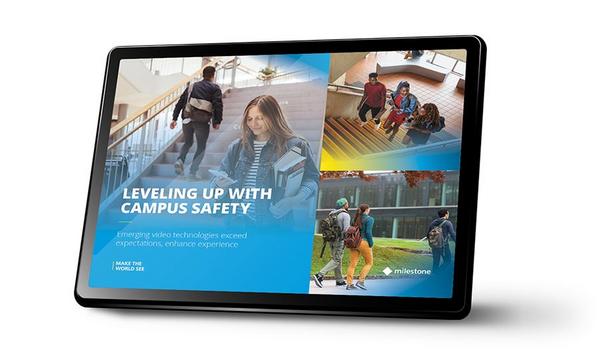
Leveling Up With Campus Safety
Download
Smart Surveillance In The Workplace
Download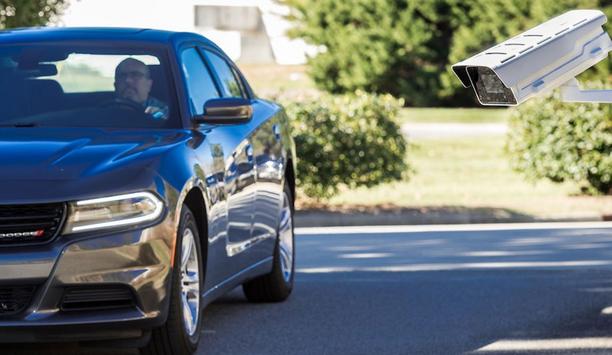
How To Ramp Up Perimeter Security With License Plate Reader Technology
Download
Thermal Cameras: Can They Accurately Detect Body Temperatures?
Download
How Plate Reader Technology Increases Your Perimeter Security
Download

Videos
Perimeter security: Manufacturers & Suppliers
- Senstar Perimeter security
- OPTEX Perimeter security
- eneo Perimeter security
- DSC Perimeter security
- Dahua Technology Perimeter security
- Climax Technology Perimeter security
- Gallagher Perimeter security
- Axis Communications Perimeter security
- RISCO Group Perimeter security
- Bosch Perimeter security
- Aritech Perimeter security
- Hikvision Perimeter security
- SightLogix Perimeter security
- Honeywell Security Perimeter security
